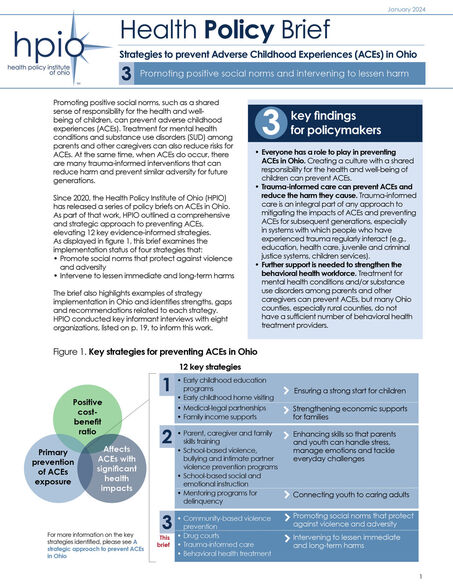Strategies to prevent Adverse Childhood Experiences (ACEs) in Ohio
Promoting positive social norms and intervening to lessen harm
Since 2020, HPIO has released a series of policy briefs on ACEs in Ohio.
As part of that work, HPIO outlined a comprehensive and strategic approach to preventing ACEs, elevating 12 key evidence-informed strategies.
This brief examines the implementation status of four strategies that:
- Promote social norms that protect against violence and adversity
- Intervene to lessen immediate and long-term harms
The brief also highlights examples of strategy implementation in Ohio and identifies strengths, gaps and recommendations related to each strategy. HPIO conducted key informant interviews with eight organizations to inform this work.
Members of HPIO’s ACEs Advisory Group provided guidance and feedback on the development of this brief.
Support for this project was provided by the Harmony Project, the Ohio Children’s Hospital Association and HPIO’s other core funders.
3 Key Findings for Policymakers
- Everyone has a role to play in preventing ACEs in Ohio. Creating a culture with a shared responsibility for the health and well-being of children can prevent ACEs.
- Trauma-informed care can prevent ACEs and reduce the harm they cause. Trauma-informed care is an integral part of any approach to mitigating the impacts of ACEs and preventing ACEs for subsequent generations, especially in systems with which people who have experienced trauma regularly interact (e.g., education, health care, juvenile and criminal justice systems, children services).
- Further support is needed to strengthen the behavioral health workforce. Treatment for mental health conditions and/or substance use disorders among parents and other caregivers can prevent ACEs, but many Ohio counties, especially rural counties, do not have a sufficient number of behavioral health treatment providers.
Resources
- Facts & Figures (PowerPoint data graphics from the report for public use)
- Ohio ACEs Impact Project
- ACEs Resource page
By:
Becky Carroll, MPA
June Postalakis, BS
Published On
January 30, 2024
Table of Contents
 Download Publication
Download Publication
